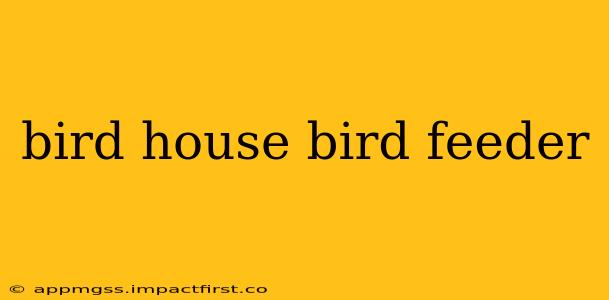Are you dreaming of a backyard filled with the cheerful songs of birds? Combining bird houses and feeders is a fantastic way to attract a variety of avian visitors and enjoy their vibrant presence. This guide will explore the best practices for attracting birds to your garden, covering everything from choosing the right birdhouse to selecting the optimal bird feeder and food.
What Kind of Birdhouse Should I Get?
The type of birdhouse you choose depends entirely on the species of bird you want to attract. Different birds have different nesting preferences. For example, smaller birds like chickadees and wrens prefer smaller houses with smaller entrance holes, while larger birds like bluebirds require larger houses with correspondingly larger entrances. Consider researching the birds common to your region to select a birdhouse that meets their specific needs. Features like drainage holes and easy-to-clean interiors are also important considerations.
What is the Best Bird Feeder for My Area?
Similar to birdhouses, the ideal bird feeder depends on the types of birds you hope to attract and the prevalent local bird species. Tube feeders are popular and work well for many small birds, while hopper feeders offer larger platforms and are suitable for a wider range of species. Suet feeders are perfect for attracting woodpeckers and other birds that appreciate high-fat foods. Consider the size and strength of the feeder, as well as its weather resistance, to ensure it can withstand the elements.
What is the Best Birdseed to Use?
The type of birdseed you choose significantly impacts which birds you'll attract. Black oil sunflower seeds are a popular choice, appealing to a wide variety of birds and offering high nutritional value. Nyjer seeds are a favorite among finches, while shelled peanuts are a treat for jays and woodpeckers. Avoid using low-quality mixes that contain fillers, as these can be less nutritious and less appealing to birds. Always consider the preferences of your target bird species when making your selection.
How Often Should I Clean My Bird Feeder?
Regular cleaning is crucial to prevent the spread of disease among birds. Clean your bird feeders at least once a month, or more frequently during warmer, wetter months. Remove old, spoiled seed and wash the feeder with a solution of mild dish soap and water. Thoroughly rinse and allow the feeder to dry completely before refilling it. This simple practice helps maintain the health of your avian guests.
What is the Best Location for a Birdhouse and Feeder?
Placement is key to attracting birds. Position your birdhouse at least 5 feet off the ground, in a sheltered location away from direct sunlight and strong winds. Ideally, it should be near trees or shrubs, providing cover for birds. Your bird feeder should also be placed in a safe location, away from predators like cats. Ideally, it should be visible from a distance but also provide some cover for the birds while feeding.
How Do I Keep Squirrels Away From My Bird Feeder?
Squirrels can be notorious for raiding bird feeders. Consider using squirrel-resistant feeders with cages or baffles to deter these clever creatures. You can also try placing your feeder in a location that is less accessible to squirrels, such as hanging it from a sturdy branch. Experiment with different strategies to find the most effective method for keeping squirrels away from your bird feeder and ensuring the birds get their fair share.
Can I Attract Specific Birds with My Birdhouse and Feeder?
Yes, by understanding the specific needs and preferences of different bird species, you can strategically select birdhouses and feeders, and choose the appropriate birdseed to attract specific types of birds. This involves research into the birds native to your region and understanding their preferences in terms of shelter, food sources, and habitat.
This guide offers a comprehensive approach to attracting birds to your yard. By carefully selecting appropriate birdhouses, feeders, and food, and by implementing good hygiene practices and strategic placement, you'll significantly improve your chances of welcoming a diverse and lively avian community to your outdoor space. Remember, consistent effort and observation will reward you with the delightful presence of your feathered friends.
